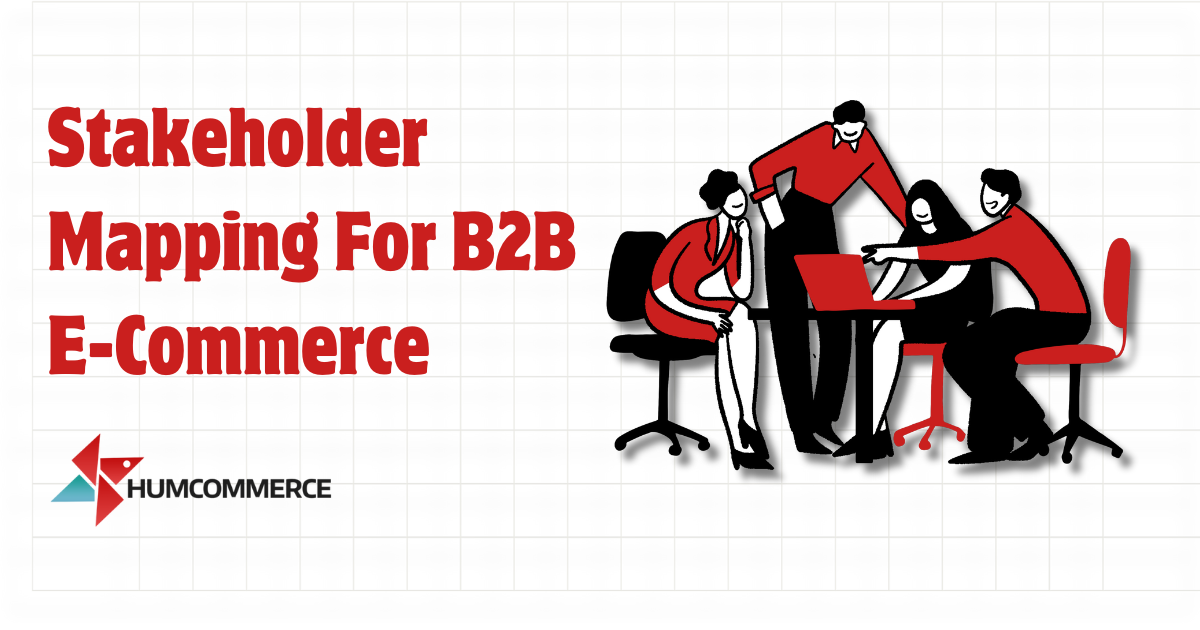Did you know that over 70% of B2B e-commerce projects fail due to a lack of stakeholder mapping knowledge? Stakeholders in B2B e-commerce include suppliers, logistics partners, clients, regulators, and investors, each with unique interests.
Stakeholder mapping allows businesses to identify, prioritize, and communicate strategically, ensuring all parties align with the company’s goals.
Here, we will dive into the essentials of stakeholder mapping, exploring best practices, tools, and common challenges to help you create a map that drives success in the complex B2B landscape.
Understanding Stakeholder Mapping in B2B E-commerce
Stakeholder mapping identifies, analyzes, and categorizes parties interested in a business’s operations and outcomes. In B2B e-commerce, where businesses engage in transactions with other businesses, stakeholder mapping is crucial due to the complexity of relationships.
Stakeholders in B2B can include suppliers, partners, logistics providers, financial institutions, and regulatory bodies, each with distinct priorities. For example, suppliers may prioritize timely payments, while logistics providers focus on efficient delivery schedules.
By understanding the needs of each stakeholder, businesses can tailor communication efforts, address concerns, and maintain strong relationships. For instance, proactive communication with a dissatisfied supplier can prevent disruptions in the supply chain.
Additionally, stakeholder mapping helps businesses identify potential conflicts or resistance, allowing them to address these issues before they escalate. Unlike B2C, where customers are the central focus, B2B e-commerce requires managing a more complex and interdependent network of relationships.
Key Stakeholders in B2B E-Commerce
B2B e-commerce involves various stakeholders, each contributing uniquely to the ecosystem:
Customers and Clients
Customers are the main revenue generators in B2B, often involving multiple departments or decision-makers. Businesses must maintain transparent and professional relationships to meet customer expectations and secure long-term contracts.
Suppliers and Manufacturers
Suppliers are responsible for providing the goods or raw materials necessary for the products sold. Effective communication and strong relationships with suppliers ensure timely deliveries and competitive pricing.
Logistics and Distribution Partners
In e-commerce, logistics and distribution partners are critical in delivering products on time and in good condition. Stakeholder mapping helps identify these partners and proactively address potential operational challenges.
Investors and Shareholders
Investors are key stakeholders. They provide capital and expect returns on their investments. They influence decision-making and strategic directions.
Regulatory Bodies
Regulatory stakeholders, such as government agencies and trade associations, set the standards and rules for e-commerce operations, including data protection, payment processing, and cybersecurity.
Internal Stakeholders (Employees, Management)
The internal team, from customer service to IT, shapes the e-commerce experience and ensures smooth operation. Mapping internal stakeholders helps in aligning efforts with business goals.
Steps to Create a Stakeholder Map for B2B E-Commerce
Creating an effective stakeholder map involves structured steps:
- Identify All Stakeholders
List every stakeholder that has any impact or interest in your business. Group them according to their roles (e.g., suppliers, customers, logistics partners). - Analyze Stakeholder Interests and Influence
Determine each stakeholder’s primary interests and level of influence over the organization’s activities. This can help in prioritizing resources. - Prioritize Stakeholders
Rank stakeholders based on their importance to the organization’s objectives. Consider factors like frequency of engagement, contract value, and degree of influence. - Develop Communication Strategies
Tailor communication strategies for each stakeholder based on their level of influence and interest. - Maintain Regular Updates
Stakeholder relationships evolve over time, so reviewing and updating the stakeholder map periodically is important.
Stakeholder Analysis Matrix for B2B E-Commerce
The stakeholder analysis matrix is a valuable tool for organizing and visualizing the influence and interest of each stakeholder. Typically, stakeholders are placed into categories such as:
- High Influence, High Interest: Must be managed closely.
- High Influence, Low Interest: Keep satisfied.
- Low Influence, High Interest: Keep informed.
- Low Influence, Low Interest: Monitor with minimal engagement.
This matrix helps businesses allocate resources effectively, ensuring that high-priority stakeholders receive appropriate attention and support.
Popular Stakeholder Mapping Models
Let’s explore a few of the popular stakeholder mapping models.
Power-Interest Grid
Classifies stakeholders based on their power and interest levels, helping to prioritize communication and engagement efforts.
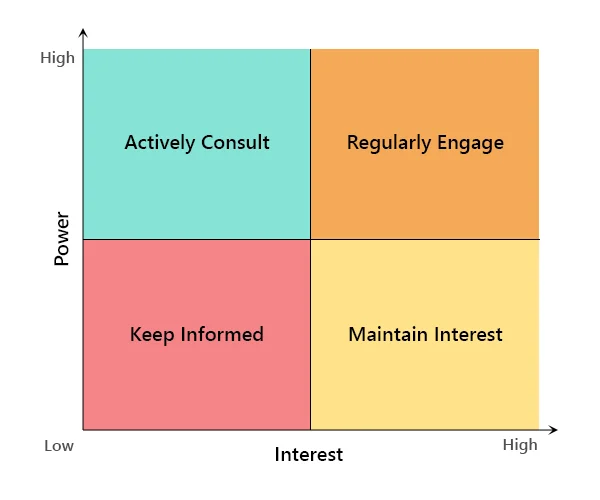
Influence-Impact Matrix
Assess stakeholders by their potential impact on business operations and their level of influence, which is useful for risk management.
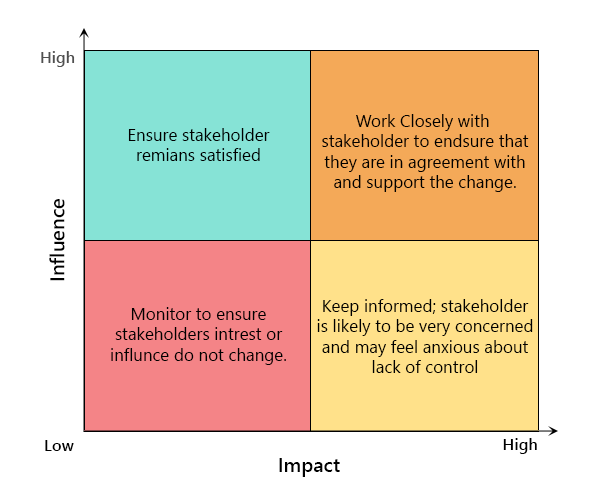
Salience Model
Segments stakeholders based on legitimacy, urgency, and influence, providing a more nuanced approach to stakeholder management.
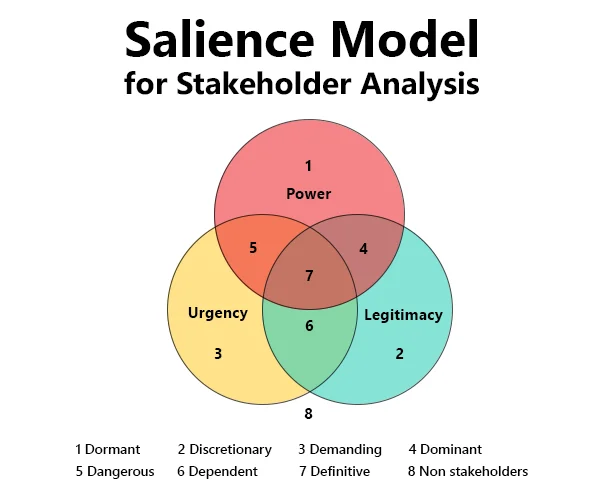
Stakeholder Onion Diagram
Visualizes stakeholder relationships by placing the organization at the center, with primary, secondary, and tertiary stakeholders layered around it.
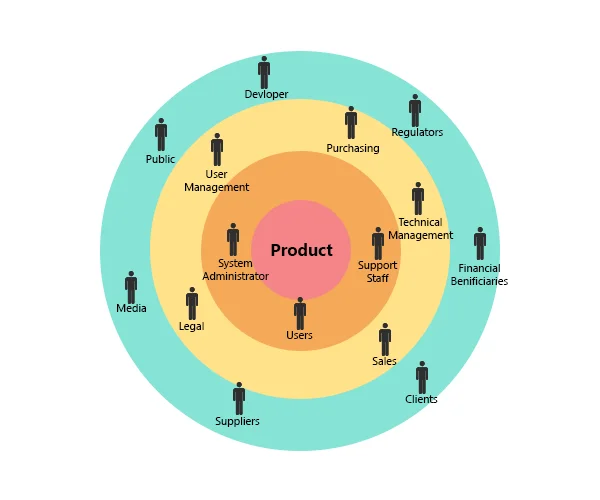
Tools and Technologies Supporting Stakeholder Mapping
A variety of tools aid in creating and managing stakeholder maps, enhancing analysis accuracy and efficiency:
- Microsoft Power BI: Visualizes data on stakeholder influence and relationships through interactive dashboards.
- Lucidchart: Provides templates for creating stakeholder maps, allowing for collaborative and accessible mapping.
- Miro: An online collaborative tool that supports brainstorming and mapping with ready-made templates.
- Trello: Helps manage stakeholder communication through task boards and is helpful in organizing feedback and updates.
- CRM Systems (Salesforce, HubSpot): CRM tools help maintain a database of stakeholder information and track communication history.
Common Challenges
Stakeholder mapping in B2B e-commerce can be complex due to:
- High Stakeholder Complexity: B2B e-commerce involves diverse and numerous stakeholders, making it difficult to address each interest adequately.
- Dynamic Stakeholder Priorities: Stakeholders’ priorities may shift, requiring continuous updates to the map.
- Resource Allocation: Balancing resources across multiple high-priority stakeholders can be challenging, especially for small businesses.
- Conflicting Interests: Stakeholders often have conflicting interests, which can complicate decision-making and strategy.
- Data Accuracy: Maintaining accurate data on stakeholder preferences and influence can be time-intensive, affecting the map’s reliability.
Future of Stakeholder Mapping
The future of stakeholder mapping in B2B e-commerce is set to be transformed by emerging technologies and data-driven strategies.
AI and machine learning, for instance, are increasingly used to predict shifts in stakeholder preferences, allowing businesses to adjust strategies proactively. For example, AI can detect patterns in supplier behavior, helping a company forecast potential disruptions and plan accordingly.
Advanced data analytics further enhances accuracy in understanding and anticipating stakeholder needs. By analyzing historical transaction data, companies can gain insights into purchasing trends, enabling them to serve high-value clients better.
Additionally, integrating stakeholder mapping with CRM systems can streamline communication and relationship management. For instance, CRM integration could enable personalized updates for stakeholders, keeping them engaged and informed.
Blockchain technology is also gaining traction for its potential to add transparency to B2B transactions. A logistics provider could use blockchain to ensure clients can verify every step of their product’s journey, building trust.
Finally, predictive stakeholder mapping leverages analytics to identify emerging stakeholders, helping businesses anticipate influences that may impact future growth and decisions.
Conclusion
In conclusion, stakeholder mapping is essential for any successful B2B e-commerce strategy. It enables businesses to foster strong relationships, enhance communication, and mitigate risks. As the digital landscape evolves, leveraging tools like AI, data analytics, and CRM integration will be critical for anticipating and meeting stakeholder needs.
At HumCommerce, we assist clients in this journey by providing advanced, data-driven solutions tailored to stakeholder management. Our tools streamline the mapping process and empower clients to adapt swiftly to shifts in stakeholder influence, ensuring sustainable growth.
With a strategic approach to stakeholder mapping, businesses can gain a competitive edge by aligning every relationship with their goals and vision for the future.
If you liked reading this article, consider going through the following.
- E-Commerce Analytics and Insights
- Business Tailored PIM solution
- Optimize Magento Store Performance Audit
Are you ready to map the stakeholders of your B2B business? We can help you with this. Contact HumCommerce today!
Frequently Asked Questions
What is stakeholder mapping in B2B e-commerce?
Stakeholder mapping is the process of identifying and analyzing all entities with an interest or influence in a B2B business’s operations.
Which tools are best for stakeholder mapping?
For effective stakeholder mapping, tools like Microsoft Power BI, Lucidchart, and CRM systems like Salesforce and HubSpot are commonly used.
How does stakeholder mapping impact business strategy?
It provides insights into stakeholder needs and influences, allowing businesses to make informed decisions and mitigate risks.
